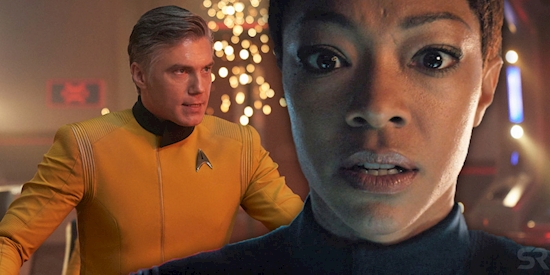Discovery Hit The Reset Button On A Major Star Trek Trope
Star Trek: Discovery ended season 2 by upending one of the franchises most heavily leaned-on tropes. By sending the USS Discovery 950 years into the future (and about 50,000 light years from home), Star Trek took the reset button used by earlier series to keep stories contained within a single episode and employed it brilliantly to flip the show’s premise. Previously, the reset device had been used to ensure game-changing developments just like that one wouldn’t happen.
From the start, Star Trek: Discovery faced its fair share of naysayers due to its bold changes in format and additions to Star Trek canon. Instead of a the traditional ensemble structure, which up until 2017 had featured a captain (or commander) leading a crew of supporting cast, Star Trek: Discovery debuted focusing on a disgraced lieutenant with her fellow cast members pulled from "lower decks" positions rather than the senior staff that typically rounded out Star Trek casts.
Click the button below to start this article in quick view. Start nowAnother huge development was the embrace of fully serialized storytelling in place of the strict episodic style that nearly other every series had followed. Those two major adjustments created a new iteration of the franchise that reflected the massive evolution television underwent in the near two decades since Star Trek had a show on the air. Discovery is the first Star Trek series not to take place in front of the static backdrop of a starship that never promoted anybody. The lack of safety net inherent in its makeup automatically raised the stakes and brought Star Trek roaring into the age of prestige television. This isn't to say the episodic nature of previous series wasn't necessary and functional at the time, just that Discovery shed an old tradition at the perfect time.
Star Trek Reset Button Was a Cornerstone of the Franchise Due to Syndication
NBC cancelled the Original Series after only three seasons, but the show went to serve as a defining example of the power of syndication in the years immediately following. Paramount’s to thank for that – after purchasing Desilu Studios, they licensed Star Trek for syndication and said syndication proved to be one of the most profitable signal boosts in history. The foundations of Star Trek’s longevity were laid down in the '70s when reruns aired with enough regularity in enough markets to pull in a huge cult fanbase and generate no small amount of hype. Eventually that noise helped Gene Roddenberry reignite the franchise with feature films and Star Trek: The Next Generation, ultimately creating an unprecedented legacy within sci-fi television and film. Star Trek has enjoyed a long and prosperous life due to its fans, and many of those fans started their love affair with the after it had actually aired. When it comes to Star Trek, the importance of syndication cannot be understated – it's the way most fans watched in the first place.
While Star Trek: The Next Generation was a huge mainstream success, it and Deep Space Nine were both aired in syndication until Paramount launched UPN and used the network as a home for Star Trek: Voyager and Star Trek: Enterprise. Part of the reason syndication worked so well for Star Trek, historically, is because not only was the show extremely available, but it was also accessible to fans at virtually any point in the series. That's next to impossible to do with most shows today - imagine jumping into Game of Thrones season 8 with no preamble. But it’s important to remember that serialized storytelling is a concept that has only reached mainstream popularity in the last two decades, and had it been around when Star Trek first went into syndication, the franchise might have enjoyed the same fervent success. The near procedural-style of Star Trek and Star Trek: The Next Generation especially allowed the franchise to gobble up more fans and faster, which turned out to be a key component of its survival. Hence the birth of the Star Trek Reset Button.
Writers were directed to keep each episode unrelated and only introduce major paradigm shifts when absolutely necessary. For example, very few actors left Star Trek because of a narrative-based decision, but rather the shows were forced to explain an actor’s decision not to renew a contract or sign a longer one. In the case of Star Trek: Voyager, despite Deep Space Nine’s foray into serialized stories, the show was under direct orders from Paramount to keep stories bottled in a single episode so that viewers could hop onto the series at any point in its run, just as they had done with its predecessors. It’s why, despite whatever developments happened in a single episode or even a two-parter, almost always TOS, TNG, and Voyager were “reset” to factory settings at the end of an episode or arc. Everyone kept the same job, the same relationships, and the same characterization story to story, no matter what had happened to them the week before. It was a move that did, without a doubt, allow more fans to come to the series as it progressed and grew in popularity, but the reset button also inhibited creativity.
Page 2 of 3: Deep Space Nine Abolished The Rest Button - Why?
1 2 3Source: screenrant.com

